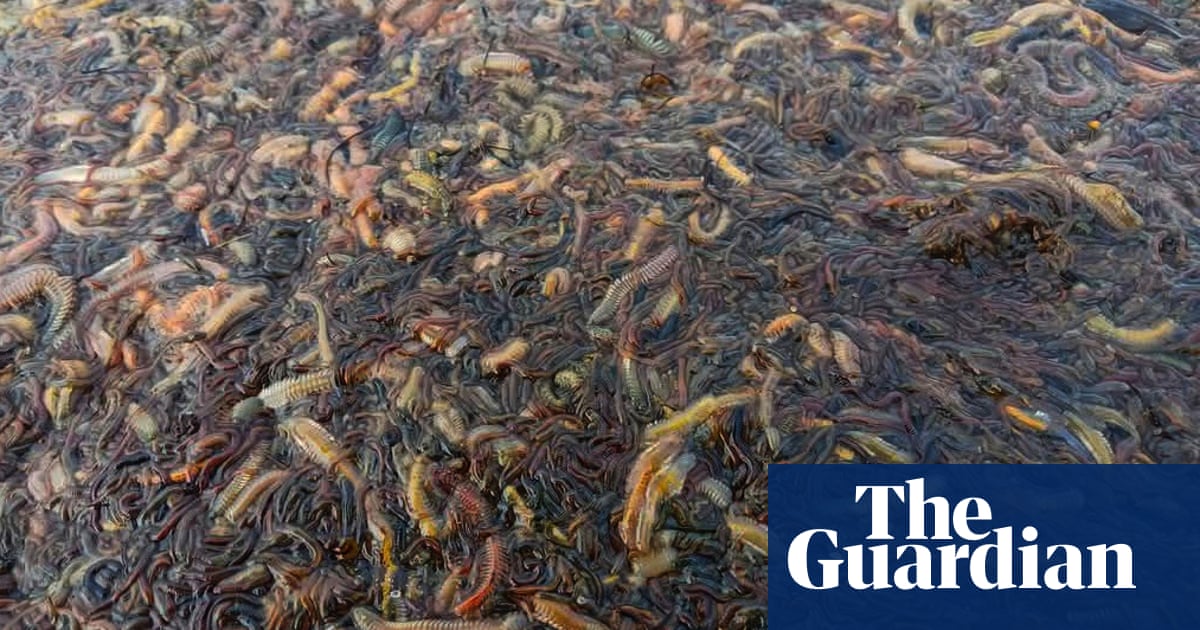When South Australia’s algal bloom arrived in the Coorong, it stained the water like strong tea before turning it into a slurry of dead worms.
Many had hoped the storm in late May would break up the bloom ofKarenia mikimotoialgae, which has killed more than200 different marine species. Instead, high tides swept the algaeinto the Coorong, an internationally significant Ramsar wetland at the mouth of the Murray River.
Once there, the algae began “reproducing madly” in the nutrient richwaters of the North Lagoon, according to estuarine ecologist Faith Coleman.
Among the dead were mostly benthic species – estuarine snails, shore crabs, baby flounder and “a thick stew of dead polychaete worms” – a crucial food source for shorebirds and fish.
Levels had declined from their peak but the smell of rotting fish remained, along with algal spores buried in the sediment. “As soon as it warms up again, the likelihood is [the algal bloom will] be back,” Coleman said.
The marine heatwave, a contributing factor to the bloom, persisted off the coast of SA, according to an11 June update, which showed increases in chlorophyll – an indicator of algae concentrations – along the Coorong coast and western Gulf Saint Vincent.
Fourth generation fisherman Gary Hera-Singh was one of the first to notice the lagoon’s colour turn a “dark, orangey-brown”.
“We had a big storm event, a lot of seawater got pushed around, and this algal bloom found its way into the Coorong and has just created havoc since,” he said, and there were still “massive patches – 100 acres at a time” where the bloom was flourishing.
Hera-Singh has witnessed the health of the Coorong decline in his lifetime, but said in 41 years of fishing the impact of the algal bloom was the worst event he had seen.
The Coorong, a 120km narrow band of water separated by sand dunes from the Southern Ocean, together with lakes Alexandrina and Albert, is considered a wetland of international significance, providing critical habitat for fish, water birds and many threatened species. The North Lagoon – the area affected – is an important nursery for fish such as mulloway and bream.
Sign up for Guardian Australia’s breaking news email
Prof Peter Gell, an expert in Ramsar listed wetlands, said the wetlands had degraded over a long period of time, with barrages (structures that control water flow) added in the 1950s, higher nutrient loads and extended periods of reduced flow from the Murray.
Algal blooms were symptoms of broader changes, he said. “Because of this we’re seeing – both offshore and within the Coorong – substantial changes in the food web.”
As a wetland of international significance, the Australian government was obliged to report environmental changes to the Coorong under the Ramsar convention, Gell said, a process that usually triggered restoration efforts.
Federal and state governments were liaising about the situation, including any long-term impacts likely to affect the ecological character of the Coorong, a federal environment department spokesperson said.
“We understand that, given the dynamics of the North Lagoon, it is difficult to dissipate the bloom and it might remain for some time.”
Fresh water may help the situation, Coleman said, given the algae thrived at salinity levels of 18-37 grams per litre. Restoration efforts would help build the resilience of the Coorong and marine areas, she said.
The system was already under pressure, said Dr Nick Whiterod, an ecologist and science program manager at the Coorong Lower Lakes Murray Mouth Research Centre. But the recentdroughtand unusual algal blooms had been “eye openers” to many people, he said.
Last year, a tropical species of blue-green algal bloomed in Lake Alexandrina for the first time, and had persisted, Whiterod said. Now thatkarenia mikimotoihad got into the Coorong, there was concern it too would bloom again.
The Coorong was vulnerable to the impacts of climate change, like sea level rise and reduced river flows, he said.
“Ocean temperatures are heating up. It’s creating conditions that are conducive to algal blooms all around the world,” he said. “Our ecosystems are really stressed, we are getting to a period of time where some may not have the capacity to recover.”
